December 17, 2017 - January 13, 2018: Issue 342
Dolls
No 4 In: Really Bad Poetry for Children
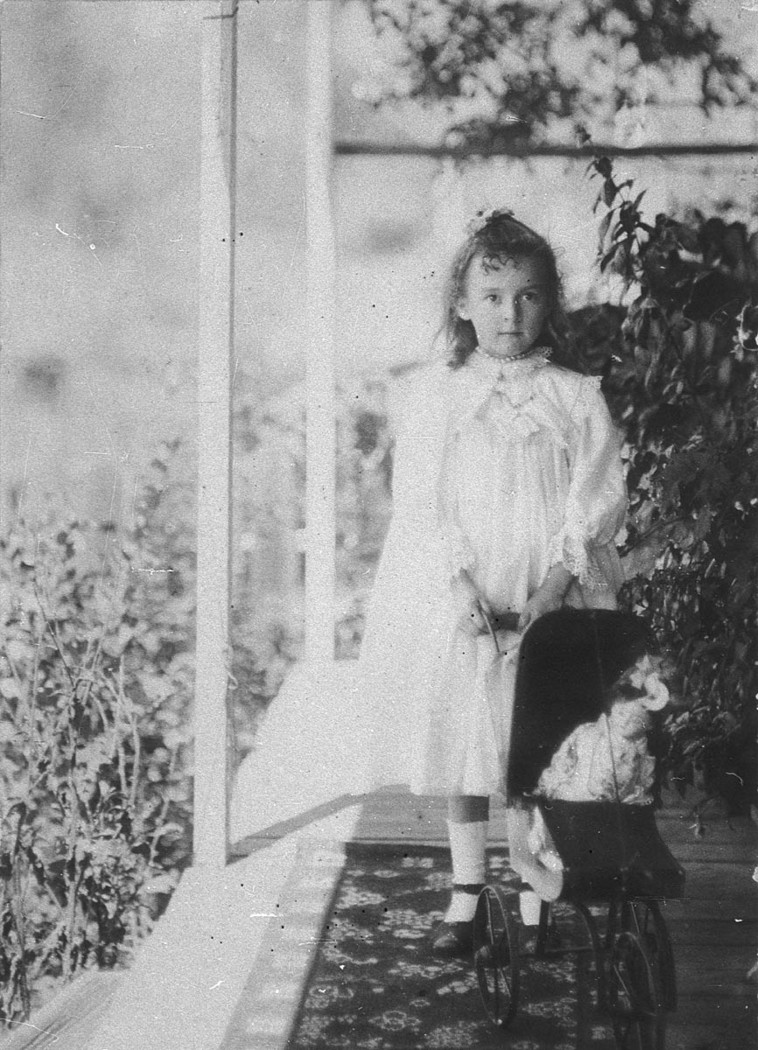
Dolls
We firmly believe that children should be allowed to be children
And this means getting to play
Play all day in the mud like grubs
Or play all day in the yard with balls and toys
Toys that are meant for girls and boys
Teddy Bears, with soft furry bellies
Pooh Bears and piglets,
Little cars with big personalities,
And Toy Soldiers,
Action heroes; such as Superman
Which are all dolls, all kinds of dolls
Small, big, tall and small
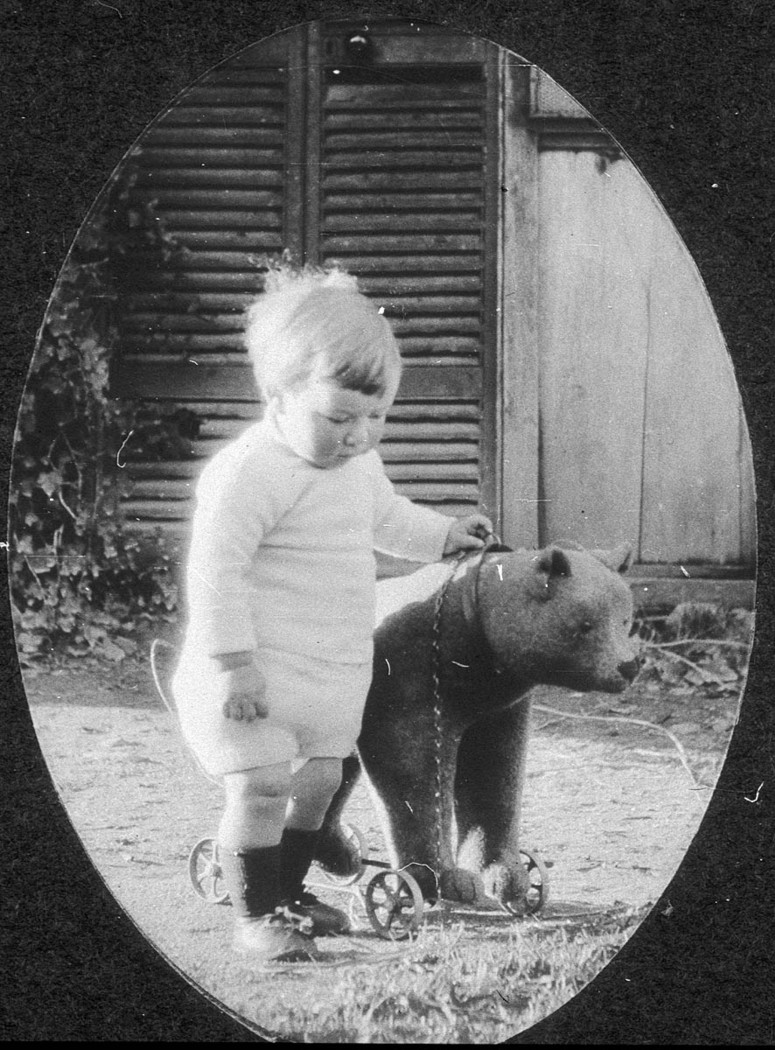
Little boy with toy bear - Deepwater, NSW, Photographed by - G Robertson-Cuninghame, circa 1909. Image No.: bcp_02542, from and courtesy of from the collections of the State Library of New South Wales
Dolls you can take in the pool,
Dolls you can teach in your own home doll school
So you see, there is,
A whole family of dolls
Boys, girls, horses, unicorns, cows, even ducks
You can have a doll’s Tea Party - some of these happen elsewhere on a very grand scale
Here's a poster for one that happened in Ireland this year where you could create new doll clothes;

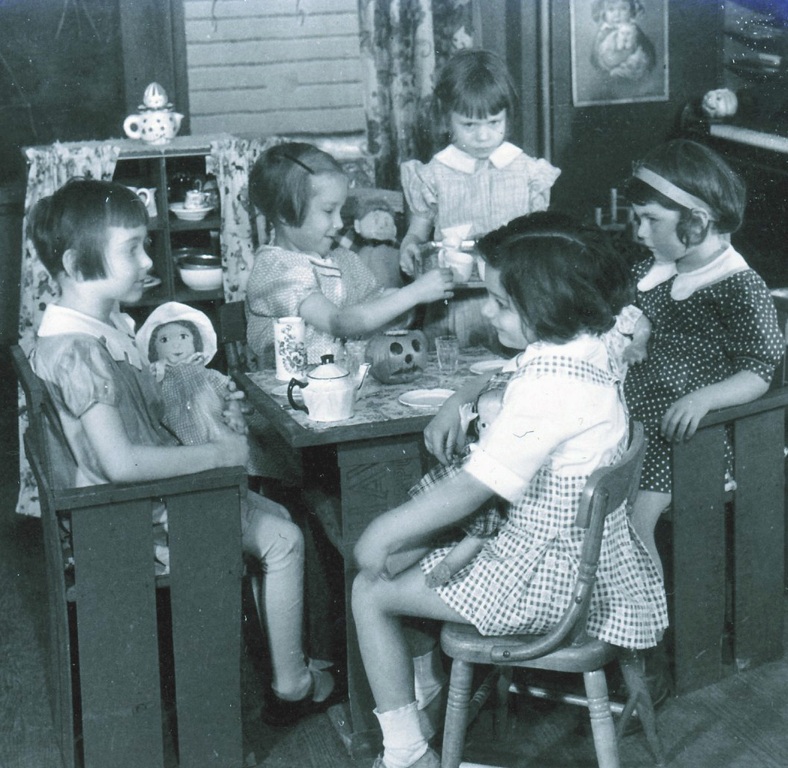
Dolls tea party during Halloween
You can throw a dolls Dance Party
Be part of a doll’s exploration of the big wide world inside the garden
Filled with flowers
Climbing trees
Dolls love to have fun
Now dolls are made for boys and for girls
They are something to cuddle,
Or can have something that teaches us about the world
Dolls can be sailors
Dolls can be little mice
Dolls can be just about anything we dream of
Mostly they are nice
The very first doll was made thousands of years ago
These were made from clay
Some were made from corn cobs - and still are today!
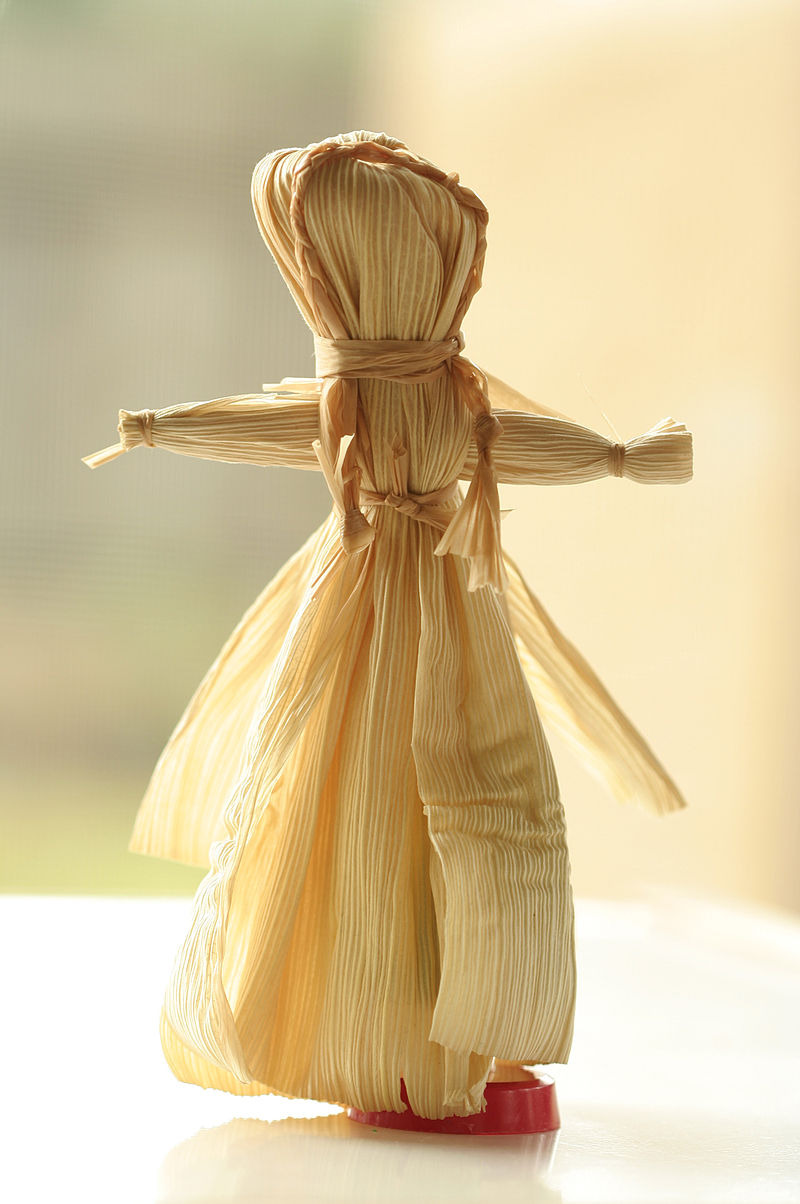
A traditional Native American corn husk doll courtesy John Morgan: Traditional native American design at San Jose Discovery Museum.
Others had dresses made from flax
Some were made from wooden bits
And painted with colours made from plants
Some are made from cloth
Others from paper
Some are made from porcelain
Some are called 'antique', although they still look very young to me...
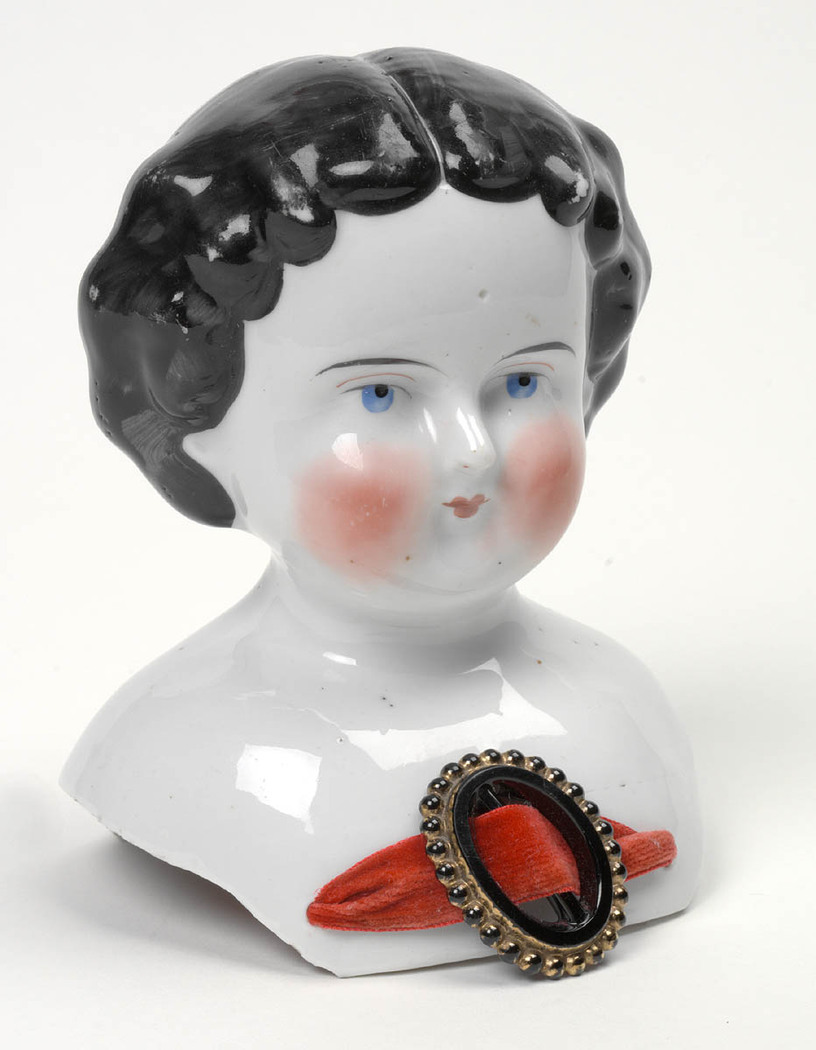
China doll's head, owned by Miles Franklin, c. 1880s, Image No.: a831001h, courtesy State Library of NSW
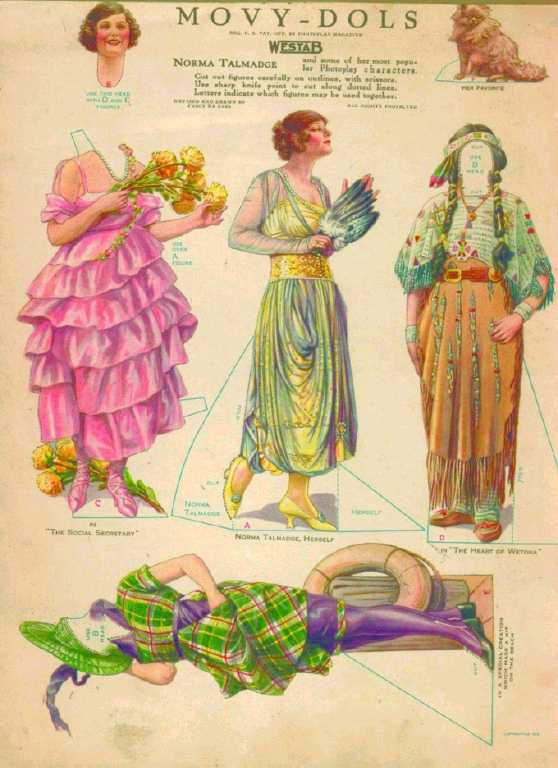
Paper doll portraying actress Norma Talmadge and some of her film costumes, 1919, "Photoplay Magazine"
There are Doll Museums and Dollhouses
Stories that have been written that tell about dolls,
There are Doll Hospitals like the one opened in Sydney in 1913
Doll Shows, to show the wonderful dolls people still make
Doll repairers like those at The Peninsula Senior Citizens Toy Repair Group at Ingleside
They lovingly restore the old dolls
So another child may love them once more
Notes:
Previous Really Bad Poetry for Children: Helmets: No 1 in Really Bad Poetry for Children Boats: No. 2 In Really Bad Poetry For Children Pets No: 3 In Really Bad Poetry For Children
Stella Maria Sarah Miles Franklin, known as Miles Franklin (14 October 1879 – 19 September 1954) was an Australian writer and feminist who is best known for her novel My Brilliant Career, published by Blackwoods of Edinburgh in 1901. While she wrote throughout her life, her other major literary success, All That Swagger, was not published until 1936.
She was committed to the development of a uniquely Australian form of literature, and she actively pursued this goal by supporting writers, literary journals, and writers' organisations. She has had a long-lasting impact on Australian literary life through her endowment of a major annual prize for literature about "Australian Life in any of its phases", the Miles Franklin Award. Her impact was further recognised in 2013 with the creation of the Stella Prize, awarded annually for the best work of literature by an Australian woman.
Franklin was born at Talbingo, New South Wales, and grew up in the Brindabella Valley on a property called Brindabella Station. She was the eldest child of Australian-born parents, John Maurice Franklin and Susannah Margaret Eleanor Franklin, née Lampe, who was the great-granddaughter of Edward Miles (or Moyle) who had arrived with the First Fleet in the Scarborough with a seven-year sentence for theft. Her family was a member of the squattocracy. She was educated at home until 1889 when she attended Thornford Public. During this period she was encouraged in her writing by her teacher, Mary Gillespie (1856–1938) and Tom Hebblewhite (1857–1923) editor of the local Goulburn newspaper.
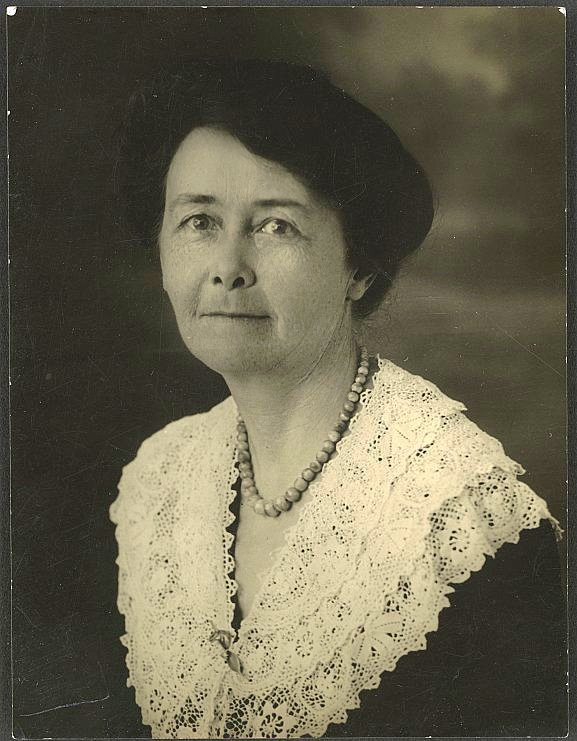
Her best known novel, My Brilliant Career, tells the story of an irrepressible teenage girl, Sybylla Melvyn, growing to womanhood in rural New South Wales. It was published in 1901 with the support of Australian writer, Henry Lawson. After its publication, Franklin tried a career in nursing, and then as a housemaid in Sydney and Melbourne. Whilst doing this she contributed pieces to The Daily Telegraph and The Sydney Morning Herald under the pseudonyms "An Old Bachelor" and "Vernacular." During this period she wrote My Career Goes Bung in which Sybylla encounters the Sydney literary set, but it was not released to the public until 1946. - From Wikipedia.- more HERE
Queen Mary’s Doll House: from DIY Dollhouse or Boatshed or Garage
For youngsters looking at this page and dreaming up how they will decorate their doll's house, boatshed or garage - here's one quite famous doll's house while yours is being built.
You can explore Queen Mary’s Doll House onlline here:
A report in a journal from the year it was completed:
THE QUEENS DOLLS' HOUSE.
THIS wonderful palace, 5ft. high to the top of the parapet, 8ft. 6in. long, 5ft. deep, has been constructed as a monument to future years of what a great house of 1924 might be like. It will be on view at the Wembley Park Exhibition. We say "might be like," for no one would be able to have such a marvellous company of artists and craftsmen work for him in reality (says the "Illustrated London News"). The scale is one inch to a foot, and so perfectly is the scale maintained that from photographs it is impossible to realise that the rooms and their furniture are not-toll sized.
The outside walls of the palace are made to rise so that every room can be perfectly seen. The garden, with every sort of flower —even with a fairy-ring of toadstools one-eighth of an inch high, folds up like a writing-desk and slides into the basement, just as the garage (containing Rolls Royce, Daimler, Sunbeam, and Vauxhall cars) does at the other end. The centre of the main front is taken up with the great staircase hall, thirty-one inches broad; the paving is of marble lapis lazuli, and the walls are painted by William Nicholson, in blue and white, with "The Expulsion from Eden," a picture in which all the animals are seen present at the disgrace of Adam and Eve. A lift with external control is held by many to be the most marvellous contrivance in the palace.
The Queen's bedroom, with a black, red, and yellow ceiling by Glyn Philpot, A.R.A., is only twenty-two inches high, yet its grey silk hangings and bed, walnut furniture, carpet, and even the blue enamelled toilet-set and the photograph of the King, are all perfect. The King's bathroom is in white and dark-green marble, and has every toilet convenience. A different kind of perfection is seen in the dining room, the ceiling of which is by Professor Gerald Moira; there is a portrait group of Queen Victoria and the Prince Consort with their children, by M'Evoy; While Munnings' portrait of the Prince of Wales out hunting hangs above the chimney piece.
With a table just 10 inches long, and equipped to the smallest details, including saucepans and jars, rolling-pin, egg-cups, and egg whisk : The kitchen in the Queen's dolls' house. Every detail, down to the saltcellars and rolls on the table, is complete.
The library, twenty-eight inches high, is wainscotted in walnut; the books are bound in red or grey leather, and many of them are written in manuscript by the authors themselves. There are books here by Rudyard Kipling, Robert Bridges, John Galsworthy, John Masefieid, Ian Hay, Hugh Walpole, W. W. Jacobs—in fact, it is a collection at the best modern authors. On one table are writing materials, including a fountain-pen half an inch long; on another are pipes and tobacco. On a third table lie the despatch cases of all the Ministers of State. The ceiling is by William Walcot.
The nursery, painted by Edmund Dulac with fairy stories, is eight inches high, and contains every toy a child could want, including lead soldiers the aim of mosquitoes, a toy train, a model theatre, and a scooter. The ordinary bedroom…. inches wide and eight inches high, each completely furnished down to tooth-thrushes threequarters of an inch for these.
There are four bathrooms, a box-room (eight by ten inches), a strong-room with the crowns and sceptres (set with tiny little jewels), and a housemaid's closet, with sinks and Dutch tiles, each one half an inch square. Underneath are store-rooms and wine-cellars, with cases of real Johnnie Walker, and dozens of real claret and champagne, bottled and binned; In the storerooms are chocolate-boxes, soap, and pots of genuine jam and marmalade.
Electric light is fitted to every room, and—what is more-it works!
Sir Edwin Lutyens, the architect of the Cenotaph, designed the House and all its rooms, and a multitude of famous firms have contributed to its furnishing and decoration.
Her Majesty the Queen, to whom the house will be presented, has supervised its furnishing, and has given many objects herself. The proceeds of the exhibition are to go to charity, and eventually, no doubt, this marvellous miniature building will be enshrined in a museum as a perfect house of 1924, the year of the Empire Exhibition.
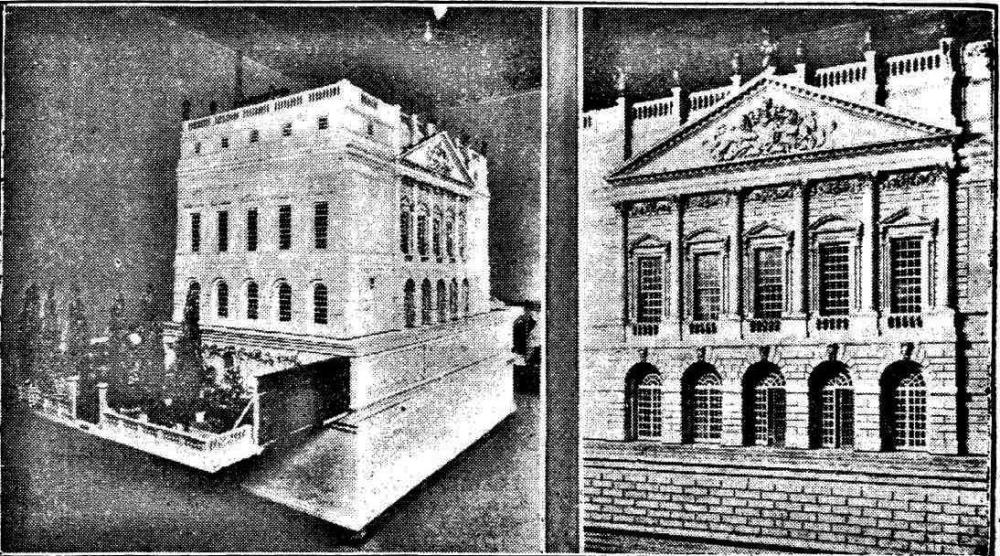
Showing how the garden can be folded over in front and pushed back into the basement: The Queen's dolls' house (8 ½ ft. long 5ft. high, and 5ft. deep).a general view of the building. With a balcony like that of Buckingham Palace, the Royal Arms above and carved, heads over the windows. The main, THE QUEEN'S DOLLS' HOUSE. (1924, March 29). The World's News (Sydney, NSW : 1901 - 1955), p. 13. Retrieved from http://nla.gov.au/nla.news-article130611266
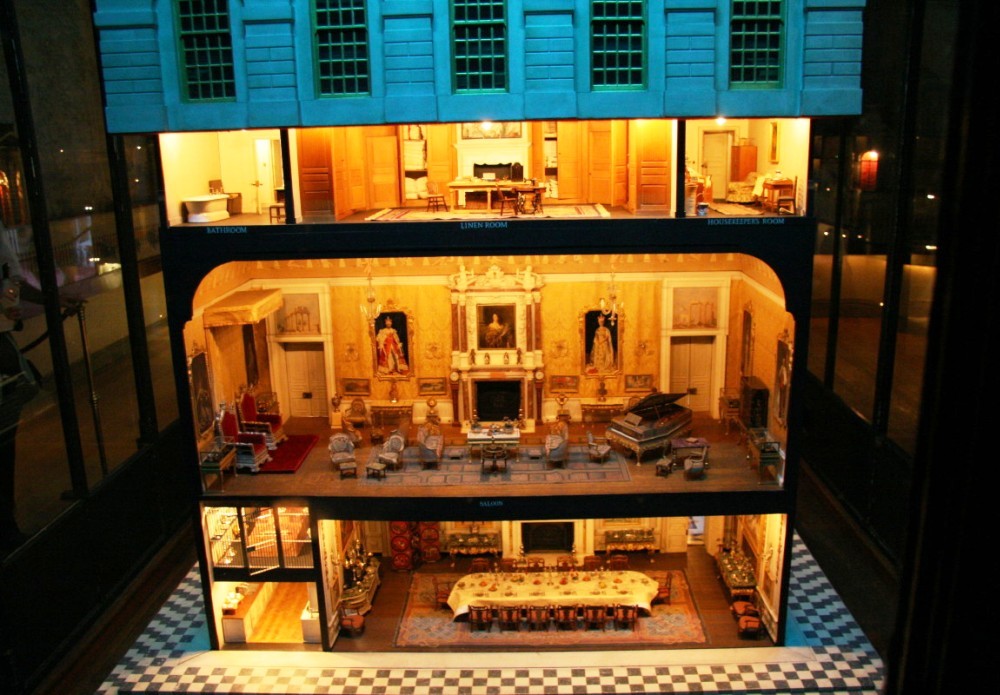
Queen Mary's Dolls' house – photo courtesy Rob Sangster - originally posted to Flickr as Queen Mary's doll house at Windsor Castle
Queen Mary's Dolls' House is a doll's house built in the early 1920s, completed in 1924, for Queen Mary, the wife of King George V. The idea for building it originally came from the Queen's cousin, Princess Marie Louise, who discussed her idea with one of the top architects of the time, Sir Edwin Lutyens, at the Royal Academy Summer Exhibition of 1921. Sir Edwin agreed to construct the dolls' house and began preparations. Princess Marie Louise had many connections in the arts and arranged for the top artists and craftsmen of the time to contribute their special abilities to the house. As a result, the dolls' house has an amazing collection of miniature items that actually work: "There are shotguns that 'break and load' (and may even fire), monogrammed linens, ... 'electricity and lifts, a garage of cars with engines that run.'" It even has running water through its tiny pipes. It was created as a gift to Queen Mary from the people, and to serve as an historical document on how a royal family might have lived during that period in England.
It showcased the very finest and most modern goods of the period. Later the dolls' house was put on display to raise funds for the Queen's charities. It was originally exhibited at the British Empire Exhibition, 1924–1925, where more than 1.6 million people came to view it, and is now on display in Windsor Castle, at Windsor, Berkshire, England, as a tourist attraction, especially to people with an interest in miniature houses, furniture, and carpets.
It was made to a scale of 1:12 (one inch to one foot), is over three feet tall, and contains models of products of well-known companies of the time. It is remarkable for its detail and the detail of the objects within it, many of which are 1/12 replicas of items in Windsor Castle. These were either made by the companies themselves, or by specialist modelmakers, such as Twining Models of Northampton, England. The carpets, curtains and furnishings are all copies of the real thing, and even the light fittings are working. The bathrooms are fully plumbed, with a flushable toilet and miniature lavatory paper.
In addition, well-known writers wrote special books for the house's library, which were bound in scale size by Sangorski & Sutcliffe. Sir Arthur Conan Doyle contributed the short story "How Watson Learned the Trick", and the ghost-story writer M. R. James wrote "The Haunted Dolls' House". A. A. Milne contributed "Vespers." Other authors included J. M. Barrie, Thomas Hardy, Rudyard Kipling and W. Somerset Maugham. Painters, including Eli Marsden Wilson, also provided miniature pictures. Even the bottles in the wine cellar were filled with the appropriate wines and spirits, and the wheels of motor vehicles were properly spoked. Queen Mary's purchases brought media attention to specialist furnishers such as Dorothy Rogers, who created needlework miniature carpets for the house. Even viewing a high quality photo of the interior will not reveal it is in fact a collection of miniatures.
There is a hidden garden revealed only when a vast drawer is pulled out from beneath the main building. This has replicas of greenery and garden implements and follows a traditional ornamental garden theme. Queen Mary's Dolls' House. (2017, May 16). In Wikipedia, The Free Encyclopedia. Retrieved from https://en.wikipedia.org/w/index.php?title=Queen_Mary%27s_Dolls%27_House&oldid=780650608
Matryoshka dolls are traditional Russian dolls, consisting of a set of hollow wooden figures that open up and nest inside each other. They typically portray traditional peasants. Also known as a Russian nesting doll, Stacking dolls, or Russian doll, is a set of wooden dolls of decreasing size placed one inside another. The name "matryoshka" (матрёшка), literally "little matron", is a diminutive form of Russian female first name "Matryona" (Матрёна) or "Matriosha".
A set of matryoshkas consists of a wooden figure which separates, top from bottom, to reveal a smaller figure of the same sort inside, which has, in turn, another figure inside of it, and so on.
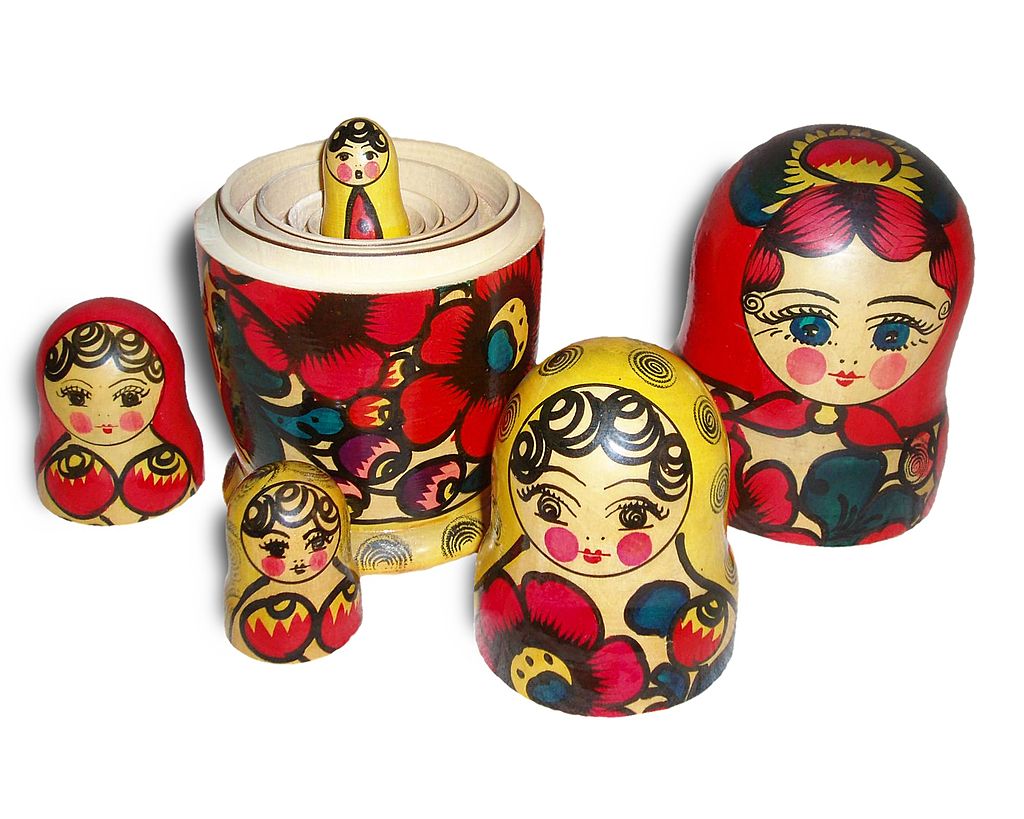
A set of Russian Matryoshka dolls taken apart, courtesy fanghong
The first Russian nested doll set was made in 1890 by Vasily Zvyozdochkin from a design by Sergey Malyutin, who was a folk crafts painter at Abramtsevo. Traditionally the outer layer is a woman, dressed in a sarafan, a long and shapeless traditional Russian peasant jumper dress. The figures inside may be of either gender; the smallest, innermost doll is typically a baby turned from a single piece of wood.
Much of the artistry is in the painting of each doll, which can be very elaborate. The dolls often follow a theme; the themes may vary, from fairy tale characters to Soviet leaders. Matryoshka dolls are often referred to as "babushka dolls", babushka meaning "grandmother" or "old woman".
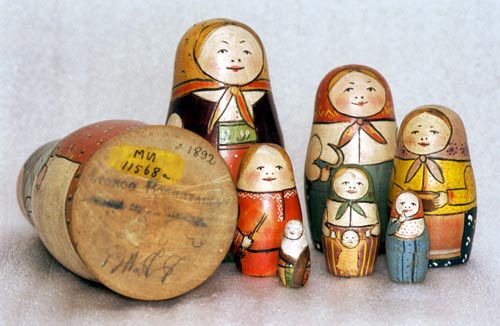
The bottom seal of the first matryoshka. Doll carved by Zvezdochkin, painted by Malyutin, 1892 - Sergiev Posad Museum of Toys, Russia
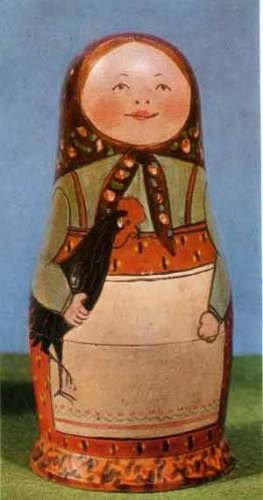
One of the first matryoshkas (Russian nesting dolls), called by some 'Rooster Girl'